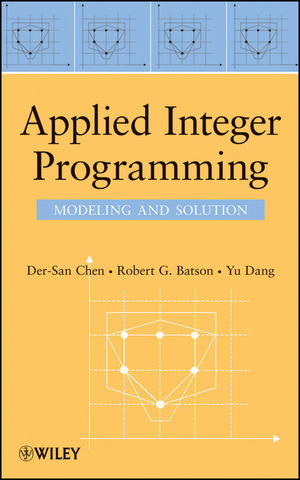A simple single machine scheduling model with sequence dependent setup times is a good example where MIP solvers are not very good yet.
The simplest formulation for the 15 job problem we show below, is probably where we use the following definition:
x(i,j) = 1 if job i is scheduled before job j
0 otherwise
Obviously we don’t need the diagonal: x(i,i). Also if we know that x(i,j) = 1-x(j,i), so we don’t need both the lower- and upper-triangular part. A model now can look like:
| $ontext
Single Machine with Sequence Dependent Setup times.
Data from: https://www.msu.edu/~rubin/files/research.html
$offtext
sets
i0 'all jobs' /job0*job15/
i(i0) 'jobs to schedule' /job1*job15/
;
alias(i,j), (i0,j0);
table data(*,*)
job1 job2 job3 job4 job5 job6 job7 job8 job9 job10 job11 job12 job13 job14 job15
proctime 88 95 98 102 100 97 100 96 102 97 108 107 102 100 96
duedate 1162 1194 1195 1196 1229 1236 1240 1301 1323 1353 1368 1402 1421 1432 1433
job0 12 7 15 19 2 14 7 19 9 3 20 0 17 13 4
job1 0 16 19 10 2 13 17 20 3 9 6 3 19 9 13
job2 1 0 10 19 3 7 9 18 20 14 10 11 17 5 7
job3 8 17 0 7 19 6 10 3 3 6 14 4 12 20 8
job4 18 13 10 0 18 1 14 4 16 3 6 13 2 2 15
job5 2 14 14 3 0 10 12 6 20 12 1 7 16 6 3
job6 4 2 10 1 16 0 20 13 17 10 15 19 12 18 6
job7 5 5 19 18 5 2 0 8 5 15 17 0 0 11 2
job8 13 18 4 15 19 13 3 0 18 14 12 16 15 16 5
job9 19 17 9 11 17 20 20 3 0 2 10 4 0 8 13
job10 13 6 20 19 15 13 12 7 5 0 11 5 5 8 7
job11 11 9 3 10 11 0 9 19 18 4 0 14 3 19 3
job12 14 17 18 10 0 13 0 20 19 8 4 0 1 18 15
job13 7 20 1 10 12 0 7 13 5 13 5 11 0 20 4
job14 7 14 17 13 19 10 11 10 15 9 5 2 10 0 5
job15 0 5 6 18 12 8 20 0 1 17 7 18 12 18 0
;
parameters
proctime(i)
setuptime(i0,j)
duedate(i)
;
proctime(i) = data('proctime',i);
setuptime(i0,j) = data(i0,j);
duedate(i) = data('duedate',i);
scalar M;
M = sum((i0,j),setuptime(i0,j))+sum(i,proctime(i));
M = sum(j, smax(i0,setuptime(i0,j)) + proctime(j)); variables
x(i,j) 'j later than i'
starttime(i) 'start of job'
endtime(i) 'end of job'
makespan 'total makespan'
z 'objective variable'
late(i) 'lateness tardiness of job'
;
binary variables x;
positive variables late,starttime,endtime;
equations
calcstart1 'bound on starttime'
calcstart2 'bound on starttime'
calcstart3 'bound on starttime'
ontime 'compare endtime with duedate'
emakespan 'bound on makespan'
calcendtime 'end=start+proc'
obj 'objective'
;
set lt(i,j);
lt(i,j)$(ord(i)<ord(j))=yes;
calcstart1(lt(i,j)).. starttime(j) =g= endtime(i) + setuptime(i,j) - M*(1-x(i,j));
calcstart2(lt(j,i)).. starttime(j) =g= endtime(i) + setuptime(i,j) - M*x(j,i);
calcstart3(i).. starttime(i) =g= setuptime('job0',i);
calcendtime(i).. endtime(i) =e= starttime(i) + proctime(i);
ontime(i).. endtime(i) =l= duedate(i) + late(i);
emakespan(i).. makespan =g= endtime(i);
obj.. z =e= 0*makespan + 1*sum(i,late(i));
* initial solution: use mipstart to load it
x.l(lt(i,j)) = 1;
option optcr=0, reslim=3600;
model m1 /all/;
solve m1 minimizing z using mip;
display x.l,starttime.l,endtime.l;
|
We can find the optimal solution of 90 in about an hour or so (running on one thread):

However, as we can see we are far from proving this is indeed the optimal solution: the best bound has not moved at all.
Notes:
- Constraint calcstart3 can be written as a bound. Of course these days, a MIP solver will do that for you in the pre-solve phase.
- The initial solution was constructed by ordering the jobs by due date.
- The Gantt chart for the machine can look like:

Here the late jobs are colored red. - The model minimizes sum of
lateness tardiness. Additional objectives could be number of late jobs and total makespan. - More difficult to model is this: scheduled downtime. If jobs can not be interrupted, this causes holes (idle time) in the schedule.
- A different, slightly more complicated formulation would result from:
x(i,j) = 1 if job i is scheduled immediately before job j
0 otherwise - IBM Ilog’s CP solver using OPL can model sequence dependent setup times directly (see: http://publib.boulder.ibm.com/infocenter/cosinfoc/v12r3/topic/ilog.odms.cpo.help/Content/Optimization/Documentation/Optimization_Studio/_pubskel/usrcpoptimizer2793.html).
- Many papers suggest a meta-heuristic (genetic algorithm etc.) to solve this.
- Of course a MIP model can still help to define the problem correctly and to solve small instances to optimality.
- Paper for data file is: “SCHEDULING IN A SEQUENCE DEPENDENT SETUP ENVIRONMENT WITH GENETIC SEARCH”, Paul A. Rubin, Gary L. Ragatz, Computers & Operations Research, 22, no 1, jan 1995, pp 85-99.
- The paper notes that according to a survey, 70% of scheduling problems may be subject to sequence dependent setup times (this number looks a little bit high to me).
- A generalization of setup times that are sequence dependent is to consider them history dependent, i.e. dependent on a number of preceding jobs. See for instance http://onlinelibrary.wiley.com/doi/10.1002/nav.21472/abstract.
PS. After the comment from Paul Rubin, I updated the big-M calculation. This reduces the size of M from 3819 to 1775. Although this is a better formulation, an example run with Cplex, 1 thread actually shows somewhat poorer performance of the new M. In the picture below we have M1 as the old M=3819 and M2 the results for M=1775.

Sometimes with a MIP we see that a better formulation can have worse performance on certain instances.
PS2. See comment below. Officially we have tardiness = max(0,lateness). I hardly use the term tardiness: “normal people” tend to use the more intuitive earliness and lateness (both nonnegative).





